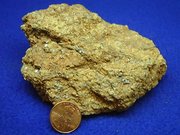Graphite
|
|
| Graphite | |
|---|---|
Missing image GraphiteUSGOV.jpg Graphite | |
| General | |
| Category | Native mineral |
| Chemical formula | Carbon, C |
| Identification | |
| Color | Steel black, to grey. |
| Crystal habit | Tabular, six-sided foliated masses, granular to compacted masses. |
| Crystal system | Trigonal |
| Cleavage | Perfect in one direction. |
| Fracture | Flaky, otherwise rough when not on clevage |
| Mohs Scale hardness | 1 - 2 |
| Luster | Dull metallic, earthy |
| Refractive index | Opaque |
| Pleochroism | None |
| Streak | Black |
| Density | 2.09–2.23 g/cm³ |
| Fusibility | ? |
| Solubility | Molten Ni |
Graphite (named by Abraham Gottlob Werner in 1789, from the Greek γραφειν: "to draw/write", for its use in pencils) is one of the allotropes of carbon. Unlike diamond, graphite is a conductor, and can be used, for instance, as the material in the electrodes of an electrical arc lamp.
Occurrence
Associated minerals include: quartz, calcite, micas, iron meteorites and tourmalines. Notable occurrences include New York and Texas in the USA, Russia, Mexico, Greenland, and India.
Other characteristics: thin flakes are flexible but inelastic, mineral can leave black marks on hands and paper, conducts electricity, and displays superlubricity. Best field indicators are softness, luster, density and streak.
Detailed properties and uses
The unit cell dimensions are a = b = 245.6 picometres, c = 669.4 pm. The carbon-carbon bond length in the bulk form is 141.8 pm, and the interlayer spacing is c/2 = 334.7 pm.
Each carbon atom possesses an sp2 orbital hybridisation. The pi orbital electrons delocalized across the hexagonal atomic sheets of carbon contribute the graphite's conductivity. In an oriented piece of graphite, conductivity parallel to these sheets is greater than that perpendicular to these sheets.
The acoustic and thermal properties of graphite are also highly anisotropic, since phonons propagate very quickly along the tightly-bound planes, but are slower to travel from one plane to another.
The loose coupling among the sheets in graphite contributes to another industrially important property -- graphite powder is used as a dry lubricant. Recent studies suggest that an effect called superlubricity can also account for this effect. When a large number of crystallographic defects bind these planes together, graphite loses this property and becomes known as pyrolytic carbon, a useful material in blood-contacting implants such as prosthetic heart valves.
It is not often used in pure form as a structural material (with the exception of reinforced carbon-carbon (RCC)) due to its brittleness, but the mechanical properties of carbon fiber composites and grey cast iron are strongly influenced by the role of graphite in these materials.
Graphite also finds use as a matrix and moderator within nuclear reactors. Its low neutron cross section also recommends it for use in proposed fusion reactors.
Graphite is also an excellent computer fan lubricant. Two or three drops into the ball-bearings of the fan will significately improve the operational abilities of the fan and quiet it down.

